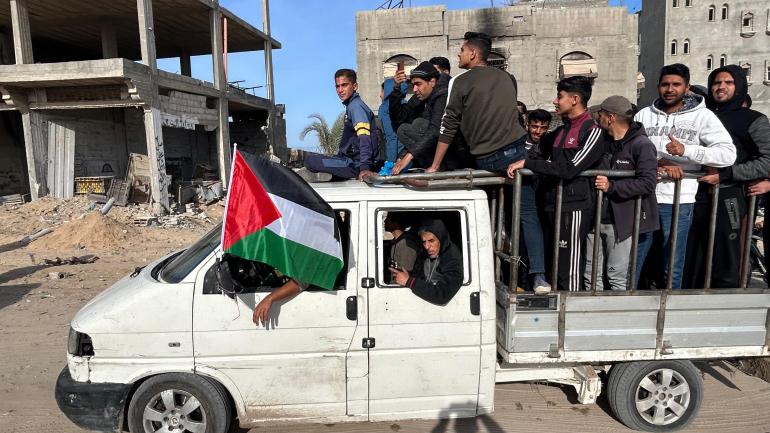Rafah, Gaza Strip, Palestine – Palestinian farmer Abd al-Sattari owned two houses in Gaza’s Rafah. He has been forced to relocate after Israeli forces have invaded the southern city for nine months. The 53-year-old had hoped that if one house was damaged in one of the Israeli attacks, which had flattened more than 70% of the territory, his family would be moved back in when the conflict was over.
On Sunday, even before the ceasefire came into effect, Abd took his eldest son Mohammed and left the rest of their family in their displacement tent in al-Mawasi, on Gaza’s southwestern coast. They rushed to one property, then the next, to face the grim reality: both his houses – one in the area of Shaboura and the other in Mirage – had been reduced to rubble. Abd’s hopes of returning to normalcy have been shattered.
More than 46, 900 people have died in the besieged enclave, over 2 million have been forced into displacement, and the much-anticipated ceasefire agreement has been in effect since Sunday morning. Even before the ceasefire began, hundreds of families were rushing back to Rafah, having fled after the Israeli invasion, with their few belongings packed into vehicles, animal-pulled carts and bikes.
Just before the ceasefire was set to end, Israeli forces continued to attack Gaza and killed more Palestinians. Some families were already moving past the darkest months of their lives by setting up camp on the remnants of what were once their homes.
As they crossed the cratered roads that crisscross Rafah, some families chanted: “We will rebuild. We will live”.
‘ Rafah is gone ‘
But for many, joy turned to anguish as they returned to devastation.
As he surveyed his first home, spanning 200 square metres (2, 000 sq ft), and his second two-storey house of 160 square metres (1, 700 sq ft), Abd found only destruction. Similar destruction was discovered in the three brothers’ homes through inspections. With no roof to shelter his family, his dreams of ending their seven-month displacement collapsed.
Sitting amid the ruins, Abd called his wife, who had been waiting in the al-Mawasi camp with the family’s belongings packed onto a truck. Over the phone, he broke the news: their homes were uninhabitable, with no walls, water or basic services. His wife wept bitterly, pleading to return despite the devastation, but Abd insisted it was impossible.
Mohammed, their eldest son, called his mother to ask her to stay put, reassured her that they would look into ways to get ready for a subsequent visit.
“The Rafah we knew is gone”, Abd lamented. “The streets where we grew up, the places we worked—they are now unrecognisable”.
For Abd’s family of six children, this day was meant to mark an end to the misery of displacement. Instead, they face the grim reality of rebuilding from nothing.
Abd reflected on their lost hopes. We believed we would eventually leave the tents and re-exist within the walls. But now, it feels like a new kind of annihilation – this time, not from bombs but from the sheer absence of life’s essentials”.

A desperate homecoming
More than 1.8 million people in Gaza were suffering from severe hunger and hundreds of thousands were living in shoddy tents that hardly protected them from a winter that had resulted in hypothermia, which is what Palestinians in Gaza have been hoping will put an end to.
Families like Nasim Abu Alwan’s, who brought his nine children back to find their home obliterated, resolved to live among the ruins. “We’ll haul water from afar if we must”, Nasim said. “We’re done with tents. We’re staying in Rafah, no matter what”.
Since the start of the war on October 7, 2023, more than 60% of all buildings and 65% of all roads in Gaza have been destroyed, according to UN data.
“More than 42 million tons of debris has been generated, within which is buried human remains and unexploded ordinance (UXO), asbestos and other hazardous substances”, the UN’s humanitarian agency’s (OCHA) report said.
Other residents of Rafah, like Amjad Abdullah, opted to stay in Khan Younis, unwilling to endure life amid the rubble. He claimed that living in this area was impossible because it was difficult to get around. “Rafah has become a graveyard of buildings. Without water, roads, or basic infrastructure, life here is unimaginable”.

According to Mohammed al-Sufi, Rafah’s mayor, the scale of destruction in Rafah is “staggering”.
“The city is uninhabitable”, he told Al Jazeera.
Al-Sufi said that “70 percent of its facilities and infrastructure are destroyed”.
“Key areas like the Philadelphi Corridor, which constitutes 16 percent of Rafah’s area, remain off-limits, while large swaths of eastern Rafah are similarly inaccessible”, he added. Along Gaza’s border with Egypt lies a section of land known as the “Philadelphi Corridor.”
Municipal workers are working overtime to clear roads, restore water, and prevent the dangers of unexploded weapons. However, the municipality issues a warning about hurried returns.
“We need a gradual, cautious approach. Without basic services, life cannot resume”, one of the workers said.
Despite the devastation, Rafah’s residents remain defiant. Families are determined to reclaim what little is left behind and stay true to their connection to the city. As one father put it, “We’ve suffered too much in exile. Rafah is home, and we will rebuild – even if it takes a lifetime”.

Leave a Reply